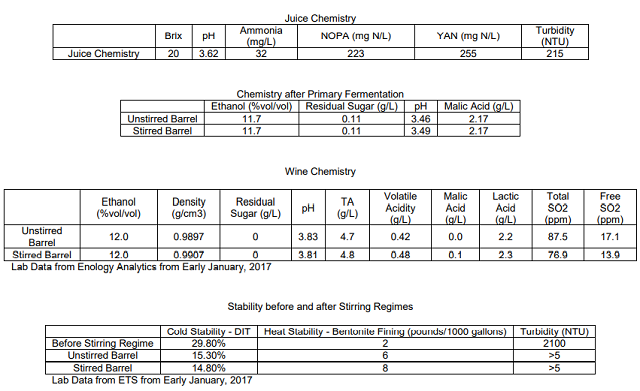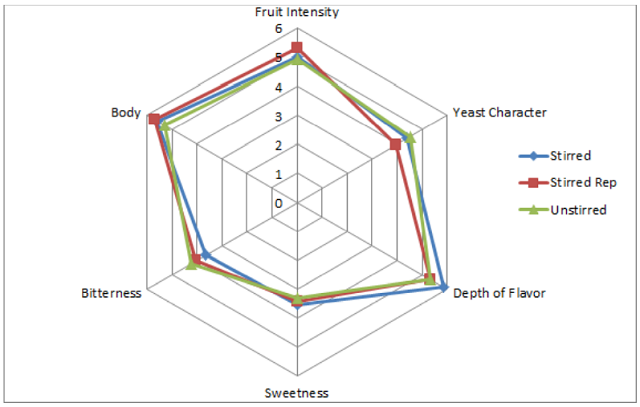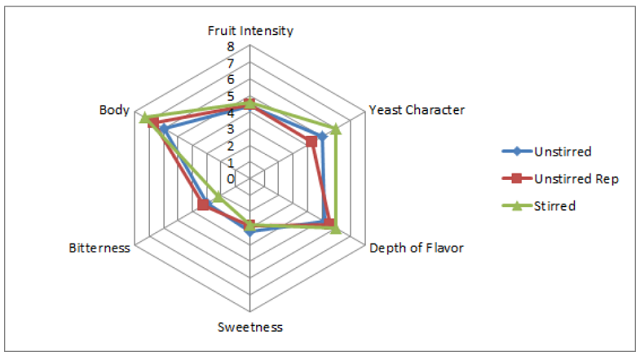Chardonnay Lees Management (2016)
Kirsty Harmon
Blenheim Vineyards
Summary
This study examined the impact of lees stirring during Chardonnay aging on the chemical and sensory qualities of the wine. It is a companion study to Blenheim’s Chardonnay Lees Management with Extralyse (ARC) study (2016). Chardonnay juice was fermented in sets of barrels, after which one was left unstirred while the other was stirred during aging. Stirring occurred once per week for 8 weeks. No major chemical differences could be observed between the finished wines. Wine tended to become more cold stable over time, but the unstirred wine required the lowest bentonite addition to become heat stable. Additionally, increasing bentonite additions to become heat stable were necessary after aging. This study suggests that stirring has a noticeable effect on finished wine, but this effect is not necessarily preferred or disliked (perhaps a slight preference towards stirred wines). The descriptors used generally did not help elucidate which qualities in wine were affected by stirring. Some trends seemed to result from stirring, such as a potential increase in body, yeast character, and depth of flavor. Bitterness may have been slightly decreased as well. However, no firm conclusions can be drawn in these regards. The stirring regime for this study was relatively short (8 weeks). In the future, more realistic stirring regimes should be implemented to see whether differences tend to increase over time
Introduction
Marchal et al. (2011) provide an excellent brief review of yeast autolysis in their introduction. Lees are mainly composed of yeast, bacteria, tartaric acid, polysaccharides, and protein-tannin complexes (Zoecklein 2013). Heavy lees generally refers to lees which precipitate 24 hours after fermentation (generally grape particles and large complexes of other lees particulates), and can often lead to off-aromas in wine. Light lees precipitate later and are generally beneficial to wine quality, and have less grape particulates and less heavily complexed yeasts and other lees particulates (Zoecklein 2005; Zoecklein 2013). Lees aging can decrease vanilla flavors from oak, and increase toasted flavors (Chatonnet et al. 1992; Tominaga et al. 2000). Others have observed that lees stirring increases yeast character in the wine, decreases fruit and oak character. In some cases, this reduction in oak character can increase the perception of fruit (relative to very oaky control wines) (Zoecklein 2005).
Lees aging also increases the polysaccharide content of wines, particularly mannoproteins, which may enhance wine protein and tartrate stability (Llaubères et al. 1987; Ledoux et al. 1992; Moine-Ledoux et al. 1997; Feuillat 2003; Zoecklein 2005; Zoecklein 2013). Sur lies aging releases mannoproteins and other cell wall polysaccharides which can enhance the colloidal structure, stability, and aromatic quality of red wines while reducing their astringency, making sur lie aging of red wines important (Zoecklein 2005). Although yeast-derived proteins can increase during lees aging, these proteins are not involved in protein instability (Zoecklein 1991).
Lees may also act to preserve fruity and varietal characteristics by preventing oxidation and producing a reducing environment (Marchal et al. 2011; Zoecklein 2013). The release of thiols into the wine from yeast has been attributed to lowering reductive characteristics by being able to oxidize methanethiol and ethanethiol into their non-volatile disulfide forms (Lavigne and Dubourdieu 1996); however, this greatly depends on other factors in the aging process, and could impart a more reductive character to the wine. Yeast glycoproteins from autolysis may also decrease astringency in wines through interaction with phenolic compounds (Escot et al. 2001). Lees autolysis can also impart sweetness to wine (Zoecklein 2005; Marchal et al. 2001), which may be in part due to sweet peptide fractions released during cell autolysis. One such fraction appears to be derived from heat shock proteins (Hsp12p) (Marchal et al. 2011), which is expressed from high temperature, ethanol, oxidative stress, and glycerol concentrations (Varela et al. 1995). All of these factors are present under winemaking conditions (Marchal et al. 2011). The breakdown of peptides can result in aromatic precursors in wines (Zoecklein 2005), but may also provide more nitrogen for spoilage organisms to consume. Many of these impacts of lees aging can be affected by winemaking practices, such as frequency of stirring, amount of lees present, amount of oxygen ingress, pectinase/glucosidase enzyme additions (such as Extralyse by Laffort), and perhaps even quality of lees. This study examines the impact of one such lees stirring regime on the chemical and sensory qualities of wine.
Results and Discussion
No major chemical differences could be observed between the finished wines. Wine tended to become more cold stable over time, but the unstirred wine required the lowest bentonite addition to become heat stable. Additionally, increasing bentonite additions to become heat stable were necessary after aging.

The wine was tasted at two different sensory sessions. On the January 25 session at Early Mountain Vineyards, of 38 people, 25 people chose the correct wine (66%) showing a statistically significant difference between wines (p<0.001). These wines were voted to have an average degree difference of 4.8 (out of 10), suggesting that the wines were moderately different. In general, there was no preference for either treatment. The comments on these wines were somewhat contradictory. No strong trends were found between wines for the sensory descriptors used in this study.


For the February 15 sensory session at Williamsburg Winery, 7 out of 10 judges were able to correctly distinguish the stirred from the unstirred wine, suggesting that these wines were significantly different (p<0.05). The wines were rated as having an average degree of difference of 4.3 (out of 10), suggesting that these wines were only moderately different. Of those judges that correctly distinguished the wines, out of 6 votes 100% of judges preferred the stirred wine. There was a strong trend for wine produced with stirring to have higher Yeast Character. Other descriptors for the wines were very similar.

This study suggests that stirring has a noticeable effect on finished wine, but this effect is not necessarily preferred or disliked (perhaps a slight preference towards stirred wines). The descriptors used generally did not help elucidate which qualities in wine were affected by stirring. Some trends seemed to result from stirring, such as a potential increase in Body, Yeast Character, and Depth of Flavor. Bitterness may have been slightly decreased as well. However, no firm conclusions can be drawn in these regards. These results may have been enhanced if the stirring regime was allowed to continue for a longer period of time, or if panelists had been trained more rigorously in descriptors and had had more replications.
Methods
Approximately 1.83 tons of Chardonnay were sourced from the same vineyard on 8/24, refrigerated at 50°F, and were whole cluster pressed on 8/26 for approximately 1250L of juice. 50 mg/L of sulfur dioxide were added at processing. Bentonite (AEB Bentogran) was added at a rate of 30g/hL as the juice exited the press and was settled overnight at 35°F. Tartaric acid was added at a rate of 1g/L to bring pH into a range of 3.4-3.6. The morning after settling (8/27), the juice was racked off of sediment to another tank to ensure homogeneity. Juice was then racked into two identical barrels. Juice was allowed to warm to approximately 50°F and 15g/hL of EC1118 yeast was added to each barrel. Fermentation was monitored daily.
After alcoholic fermentation was complete (residual sugar as measured by enzymatic assay was 2g/L or less), samples were taken from each barrel for in-house post fermentation wine chemistry. Additionally, samples were taken for heat stability and cold stability analysis. Sulfur dioxide was added at a rate of 50mg/L. These samples were taken before the beginning of the stirring regime. The stirring regime was started at 1 time per week for 45 seconds per barrel with a stainless steel barrel stirrer. Stirring was done by the same individual each time to ensure consistent and repeatable technique.
8 weeks after stirring began (December 2016), samples were taken of all barrels for polysaccharide, protein heat stability, cold stability, basic chemistry, and sensory analysis.
For the triangle test and preference analysis for the January 25 tasting, anybody who did not answer the form were removed from consideration for both triangle, degree of difference, and preference. Additionally, anybody who answered the triangle test incorrectly were removed from consideration for degree of difference and preference. Additionally, any data points for preference which did not make sense (such as a person ranking a wine and its replicate at most and least preferred, when they correctly guessed the odd wine) were removed.
In order to balance the data set to perform statistical descriptive analysis on the January 25 tasting, any judge who had not fully completed the descriptive analysis ratings were removed. Additionally, one judge seemed to purposely make all ratings the same, sense they said they could not distinguish the triangle test. As a result, this judge was removed. In order to then make the amount of judges between groups equivalent, two judges from group 3 were eliminated. This resulted in a final data set of 3 groups, each with 9 judges (considered as replications within groups, and groups were considered as assessors). Data was analyzed using Panel Check V1.4.2. Because this is not a truly statistical set-up, any results which are found to be statistically significant (p<0.05) will be denoted as a “strong trend” or a “strong tendency,” as opposed to general trends or tendencies. The statistical significance here will ignore any other significant effects or interactions which may confound the results (such as a statistically significant interaction of Judge x Wine confounding a significant result from Wine alone). The descriptors used in this study were Fruit Intensity, Yeast Character, Depth of Flavor, Sweetness, Bitterness, and Body.
The procedures for analyzing sensory analysis were the same for the February 15 tasting. In order to balance the data set for descriptive analysis, one judge was randomly removed from group one, to result in 3 groups each with 3 judges.
References
Chatonnet, P., Dubourdieu, D., and Boidron, J. N. 1992. Incidence des conditions de fermentation et d’èlevage des vins blancs secs en barriques sur leur composition en substances cèdèes par le bois de chêne. Sci. Aliments. 12:665–685.
Escot, S., Feuillat, M., Dulau, L., and Charpentier, C. 2001. Release of polysaccharides by yeasts and the influence of released polysaccharides on colour stability and wine astringency. Aust. J. Grape Wine Res. 7:153–159.
Feuillat, M. 2003. Yeast macromolecules: Origin, composition, and enological interest. Am. J. Enol. Vitic. 54:211-213.
Lavigne, V. and Dubourdieu, D. 1996. Demonstration and interpretation of the yeast lees ability to adsorb certain volatile thiols contained in wine. J. Int. Sci. Vigne Vin. 30:201–206.
Ledoux, V., Dulau, L., and Dubourdieu, D. 1992. Interprètation de l’amèlioration de la stabilitè protèique des vins au cours de l’èlevage sur lies. J. Int. Sci. Vigne Vin. 26:239–251
Llaubères, R.-M., Dubourdieu, D., and Villettaz, J.-C. 1987. Exocellular polysaccharides from Saccharomyces in Wine. J. Sci. Food Agric. 41:277–286.
Marchal, A., Marullo, P., Moine, V., and Dubourdieu, D. 2011. Influence of yeast macromolecules on sweetness in dry wines: role of the Saccharomyces cerevisiae protein Hsp12. Journal of Agricultural and Food Chemistry. 59:2004-2010.
Moine-Ledoux, V., Perrin, A., Paladin, I., and Dubourdieu, D. 1997. Premiers rèsultats de stabilisation tartrique des vins par addition de mannoprotèines purifièes (Mannostab). J. Int. Sci. Vigne Vin. 31:23–31.
Tominaga, T., Blanchard, L., Darriet, P., and Dubourdieu, D. 2000. A powerful aromatic volatile thiol, 2-furanmethanethiol, exhibiting roast coffee aroma in wines made from several Vitis vinifera grape varieties. J. Agric. Food Chem. 48:1799–1802.
Varela, J. C. S., Praekelt, U. M., Meacock, P. A., Planta, R. J., and Mager, W. H. 1995. The Saccharomyces cerevisiae HSP12 gene is activated by the high- osmolarity glycerol pathway and negatively regulated by protein kinase A. Mol. Cell. Biol. 15:6232–6245.
Zoecklein, B. 1991. Protein stability determination in juice and wine. Virginia Cooperative Extension. http://www.apps.fst.vt.edu/extension/enology/downloads/ProteinS.pdf.
Zoecklin, B. 2005. Lees Management. Enology Notes #106. http://www.apps.fst.vt.edu/extension/enology/EN/106.html.
Zoecklein, B. 2013. Nature of wine lees. Practical Winery and Vineyard. July. http://www.apps.fst.vt.edu/extension/enology/downloads/wm_issues/Nature%20of%20Wine%20Lees.pdf.
